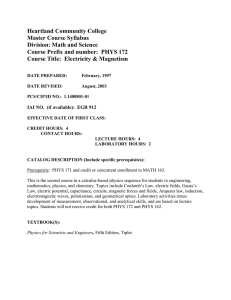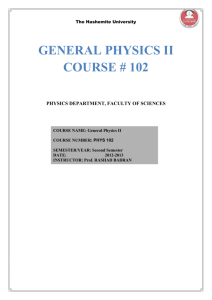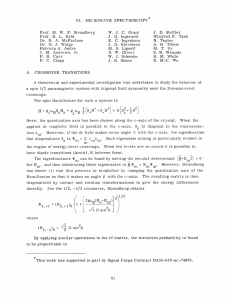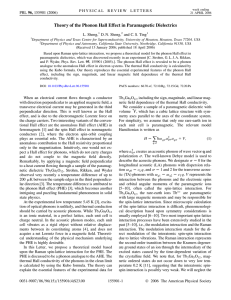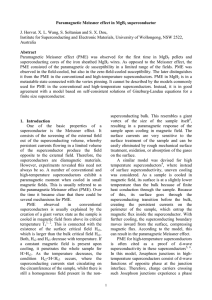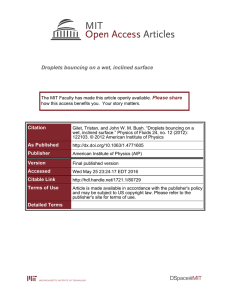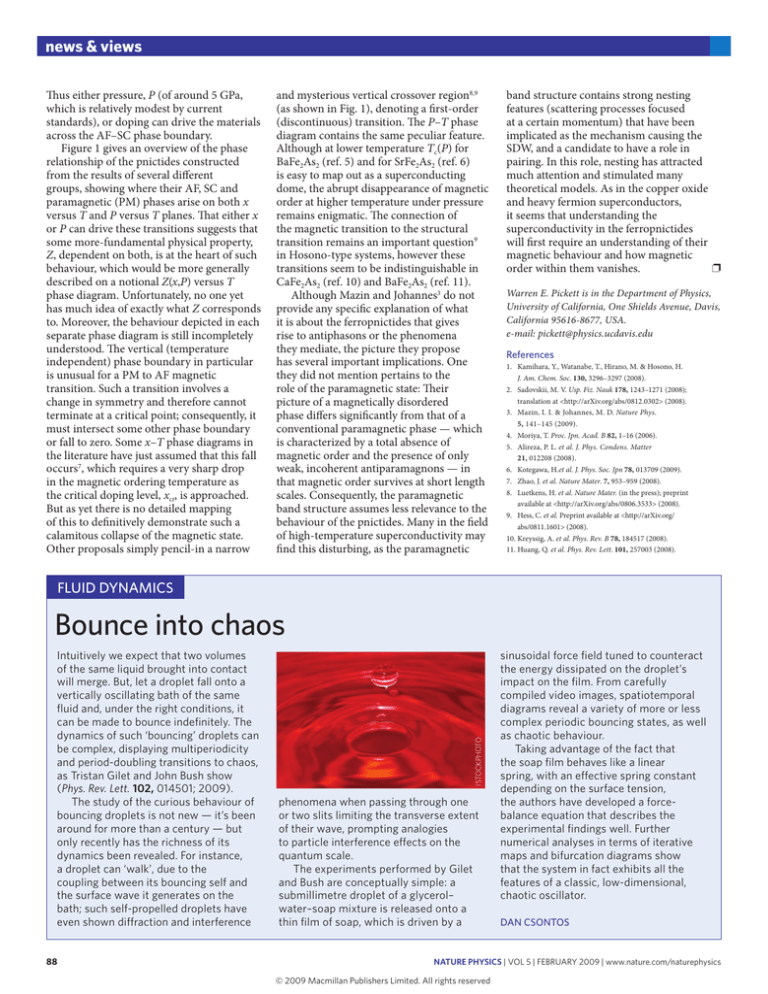
news & views
Thus either pressure, P (of around 5 GPa,
which is relatively modest by current
standards), or doping can drive the materials
across the AF–SC phase boundary.
Figure 1 gives an overview of the phase
relationship of the pnictides constructed
from the results of several different
groups, showing where their AF, SC and
paramagnetic (PM) phases arise on both x
versus T and P versus T planes. That either x
or P can drive these transitions suggests that
some more-fundamental physical property,
Z, dependent on both, is at the heart of such
behaviour, which would be more generally
described on a notional Z(x,P) versus T
phase diagram. Unfortunately, no one yet
has much idea of exactly what Z corresponds
to. Moreover, the behaviour depicted in each
separate phase diagram is still incompletely
understood. The vertical (temperature
independent) phase boundary in particular
is unusual for a PM to AF magnetic
transition. Such a transition involves a
change in symmetry and therefore cannot
terminate at a critical point; consequently, it
must intersect some other phase boundary
or fall to zero. Some x–T phase diagrams in
the literature have just assumed that this fall
occurs7, which requires a very sharp drop
in the magnetic ordering temperature as
the critical doping level, xcr, is approached.
But as yet there is no detailed mapping
of this to definitively demonstrate such a
calamitous collapse of the magnetic state.
Other proposals simply pencil-in a narrow
and mysterious vertical crossover region8,9
(as shown in Fig. 1), denoting a first-order
(discontinuous) transition. The P–T phase
diagram contains the same peculiar feature.
Although at lower temperature Tc(P) for
BaFe2As2 (ref. 5) and for SrFe2As2 (ref. 6)
is easy to map out as a superconducting
dome, the abrupt disappearance of magnetic
order at higher temperature under pressure
remains enigmatic. The connection of
the magnetic transition to the structural
transition remains an important question9
in Hosono-type systems, however these
transitions seem to be indistinguishable in
CaFe2As2 (ref. 10) and BaFe2As2 (ref. 11).
Although Mazin and Johannes3 do not
provide any specific explanation of what
it is about the ferropnictides that gives
rise to antiphasons or the phenomena
they mediate, the picture they propose
has several important implications. One
they did not mention pertains to the
role of the paramagnetic state: Their
picture of a magnetically disordered
phase differs significantly from that of a
conventional paramagnetic phase — which
is characterized by a total absence of
magnetic order and the presence of only
weak, incoherent antiparamagnons — in
that magnetic order survives at short length
scales. Consequently, the paramagnetic
band structure assumes less relevance to the
behaviour of the pnictides. Many in the field
of high-temperature superconductivity may
find this disturbing, as the paramagnetic
band structure contains strong nesting
features (scattering processes focused
at a certain momentum) that have been
implicated as the mechanism causing the
SDW, and a candidate to have a role in
pairing. In this role, nesting has attracted
much attention and stimulated many
theoretical models. As in the copper oxide
and heavy fermion superconductors,
it seems that understanding the
superconductivity in the ferropnictides
will first require an understanding of their
magnetic behaviour and how magnetic
order within them vanishes.
❐
Warren E. Pickett is in the Department of Physics,
University of California, One Shields Avenue, Davis,
California 95616‑8677, USA.
e‑mail: pickett@physics.ucdavis.edu
References
1. Kamihara, Y., Watanabe, T., Hirano, M. & Hosono, H.
J. Am. Chem. Soc. 130, 3296–3297 (2008).
2. Sadovskii, M. V. Usp. Fiz. Nauk 178, 1243–1271 (2008);
translation at <http://arXiv.org/abs/0812.0302> (2008).
3. Mazin, I. I. & Johannes, M. D. Nature Phys.
5, 141–145 (2009).
4. Moriya, T. Proc. Jpn. Acad. B 82, 1–16 (2006).
5. Alireza, P. L. et al. J. Phys. Condens. Matter
21, 012208 (2008).
6. Kotegawa, H.et al. J. Phys. Soc. Jpn 78, 013709 (2009).
7. Zhao, J. et al. Nature Mater. 7, 953–959 (2008).
8. Luetkens, H. et al. Nature Mater. (in the press); preprint
available at <http://arXiv.org/abs/0806.3533> (2008).
9. Hess, C. et al. Preprint available at <http://arXiv.org/
abs/0811.1601> (2008).
10. Kreyssig, A. et al. Phys. Rev. B 78, 184517 (2008).
11. Huang, Q. et al. Phys. Rev. Lett. 101, 257003 (2008).
FLUID DYNAMICS
Intuitively we expect that two volumes
of the same liquid brought into contact
will merge. But, let a droplet fall onto a
vertically oscillating bath of the same
fluid and, under the right conditions, it
can be made to bounce indefinitely. The
dynamics of such ‘bouncing’ droplets can
be complex, displaying multiperiodicity
and period-doubling transitions to chaos,
as Tristan Gilet and John Bush show
(Phys. Rev. Lett. 102, 014501; 2009).
The study of the curious behaviour of
bouncing droplets is not new — it’s been
around for more than a century — but
only recently has the richness of its
dynamics been revealed. For instance,
a droplet can ‘walk’, due to the
coupling between its bouncing self and
the surface wave it generates on the
bath; such self-propelled droplets have
even shown diffraction and interference
88
istockphoto
Bounce into chaos
phenomena when passing through one
or two slits limiting the transverse extent
of their wave, prompting analogies
to particle interference effects on the
quantum scale.
The experiments performed by Gilet
and Bush are conceptually simple: a
submillimetre droplet of a glycerol–
water–soap mixture is released onto a
thin film of soap, which is driven by a
sinusoidal force field tuned to counteract
the energy dissipated on the droplet’s
impact on the film. From carefully
compiled video images, spatiotemporal
diagrams reveal a variety of more or less
complex periodic bouncing states, as well
as chaotic behaviour.
Taking advantage of the fact that
the soap film behaves like a linear
spring, with an effective spring constant
depending on the surface tension,
the authors have developed a forcebalance equation that describes the
experimental findings well. Further
numerical analyses in terms of iterative
maps and bifurcation diagrams show
that the system in fact exhibits all the
features of a classic, low-dimensional,
chaotic oscillator.
DAN CSONTOS
nature physics | VOL 5 | FEBRUARY 2009 | www.nature.com/naturephysics
© 2009 Macmillan Publishers Limited. All rights reserved


